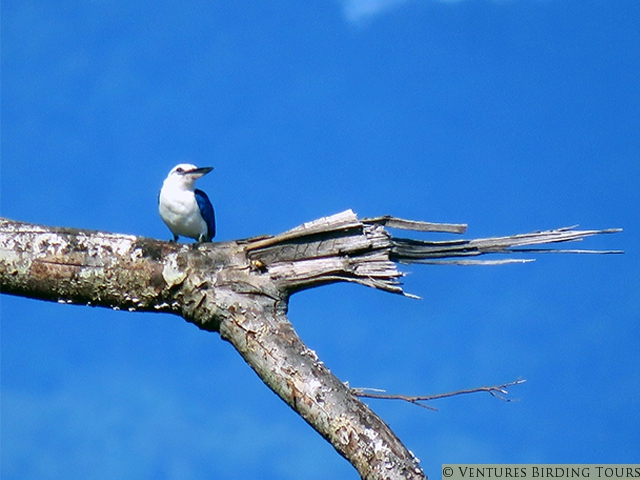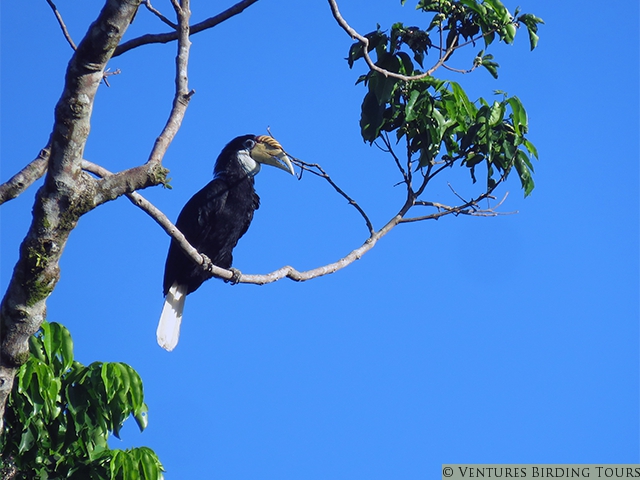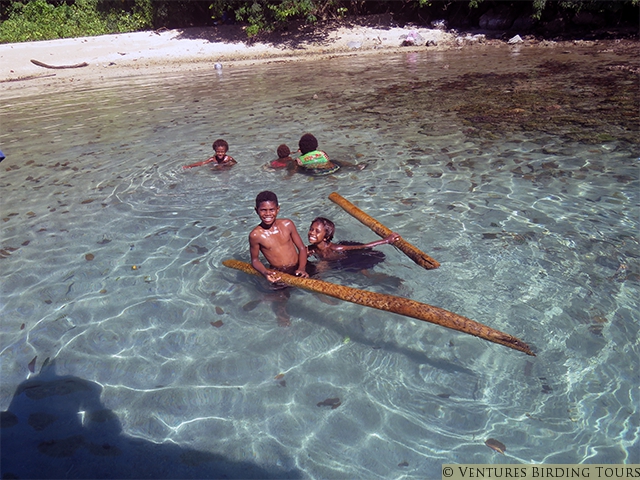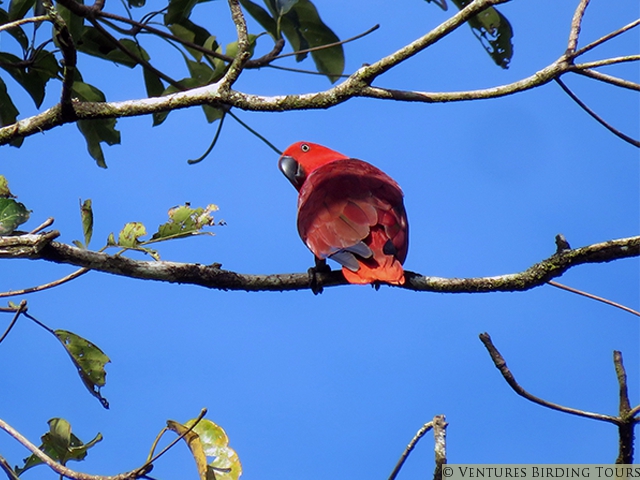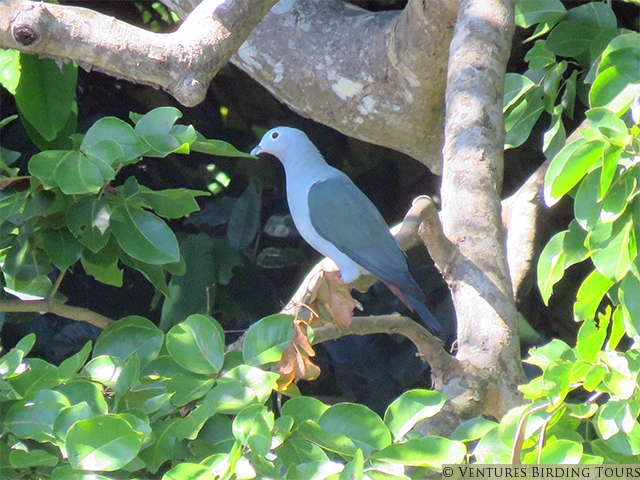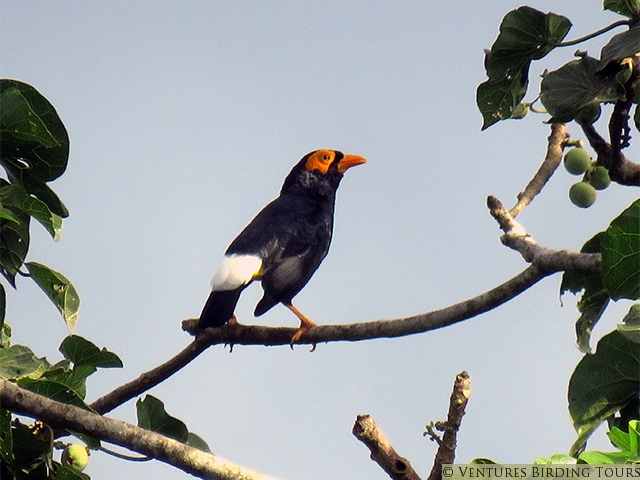June 30 Brisbane to Kimbe, New Britain
After a morning walk and a somewhat relaxing morning at Brisbane International Airport, we got to the Air Niugini desk to find the ground staff had only just found out that Hoskins Airport in West New Britain had opened an hour ago! Mt Ulawan had erupted as we left for Australia closing Hoskins Airport and leaving us unsure as to if and when the flights would leave for New Britain. Thankfully all was OK and we left on time to Port Moresby with a somewhat close connection to Hoskins, only to have un-scheduled heavy rain at Hoskins had delayed flights again. Thankfully we had an awesome pilot who circled the airport at a low elevation and got us into Hoskins without having to go back to Port Moresby! The staff from Walindi were there to meet us and transfer us the hour plus drive along the fairly dreadful roads to the resort. It was a good buffet-style dinner and an early bed as we looked forward to birding a new frontier in the morning.
July 1 Kulu River and Ela Ridge
Most of this part of lowland New Britain is covered with oil palm plantations. These Malaysian companies have converted large tracts of lowland rainforest into a mono-culture of palms. Joseph and David were our local guides and between them they knew all the sounds and where to find all of the expected species. The birding this morning was pretty good despite the somewhat drizzly conditions. Blyth’s Hornbills, Eclectus Parrots and Red-knobbed Imperial-Pigeons were common and we were confused at times by the huge Bismarck Fruit-Bats that swooped out of the tall trees in the buffer zones. The roads through the oil palm plantations were very muddy and made for gluey conditions. We returned for lunch at Walindi, which offered a wide selection of options, including several vegetarian dishes. There’s always fresh fruit and local PNG coffee available. Our first afternoon stop was Numondo Cattle Farm, a reliable spot for several grassland species, including Papuan Grassbird (recently split from Tawny), Australasian Reed Warbler and Blue-breasted (King) Quail. This is also reportedly a good shorebird spot in the northern winter. A flock of Cattle Egrets indicated that this “vagrant” species is now colonizing some of the open country on New Britain. The remainder of the afternoon was at Ela Ridge above the small oil palm village of Ela where we found a pair of White-bellied Cuckooshrike and several Yellowish Imperial-Pigeons. Dinner was 3 courses every day starting with soup (seemingly always vegetarian), followed by a buffet of fish, chicken, beef and vegetarian options. Salads are always available and desserts are freshly-baked along with fresh fruit and delicious home-made ice-cream.
July 2 Garbuna Trail Hike
The first pre-dawn song every morning is the descending “three blind mice” song of the abundant Willie-Wagtail and a pair was nesting on a small stick just off the beach at Walindi. Reaching the highlands is a challenge here so this was one of our best chances for any higher elevation species. After a short drive we picked up Chris at his house, and accompanied by Joseph and David and several of Chris’s family members, it was a gradual hike up the mountain with birding stops along the way. A flowering tree held good numbers of lorikeets, myzomelas and our only Green-fronted Hanging-Parrots of the tour. It took us some time for all of us to get good views of these tiny green parrotlets as they fed in the blossoms. We continued up into the forest where it was very quiet. Butterflies were abundant and a very good distraction when the birds were hard to find. Ulysses Swallowtails flashed their brilliant blue wings and the amazing (and huge) male and female Common Green Birdwings were often seen following each other through the forest – and also at the Walindi Resort. We turned around to have our lunch in the garden area, but not before we had views of Black-capped Paradise-Kingfisher, Black-tailed Monarch and Northern Fantail. Small birds are scarce in these forests as many species have simply not been able to colonize distant islands. We hiked back down slowly through coconut, cacao and taro gardens – a nice hike of around 5 miles but somewhat tiring due to the 1500 foot climb and the humid conditions.
July 3 Kulu River, Walindi Resort
We left Walindi pre-dawn on our way back to the Kulu River area. Introduced Cane Toads seem to be abundant throughout New Britain and they were a common sight on the roads after dark, when many are killed by cars. In the early morning hours both Bismarck Crows and Brahminy Kites were commonly seen scavenging roadkill and one assumes that these birds have learned not to eat the toxic glands of the toads. When we stopped to enjoy the spectacle Mark found a feeding Large-tailed Nightjar over the young oil palms. Both the morning and the afternoon were spent exploring the forest fragments and buffer zones in the oil palm plantations where Pacific Black Ducks were a common sight in the muddy pools. We started the day with a vigil for the elusive New Britain Pitta, which unfortunately only showed to a couple of us. It sang for quite a while, but never came out of the dense riverside vegetation. Some species which were easier to see included Varied Triller, Brush Cuckoo, Variable Goshawk and The “whooshing” noise of Blyth’s Hornbills as they flew overhead was also a common sound. We searched for the endemic Pink-legged Rail, which apparently comes out of the forest to bathe in the pools in the oil palm plantations. However the abundant rain had created a lot of suitable habitat so the birds never needed to leave the dense cover. One of the “most-wanted” birds by visiting birders has to be the almost-mythical Golden Masked-Owl which is very rare and seems to be limited to some of the oil palm plantations. We did manage an in-flight view of this dusky Barn Owl look-alike as it flew off a post and into the forest. Hopefully we will get another chance later in the week.
July 4 Pelagic Trip and Island Birding
Sea-birding in tropical oceans is always challenging, but today gave us a chance to go offshore with at least a chance for the rare Beck’s Petrel. We boarded the dive boat, which comfortably carried the 5 of us plus David and 2 crew members (Joe and Dominic) and headed out to Kimbe Island – a dot on the horizon. After about 1.5 hours of bouncing around (and seeing very little) we circled the island finding Island Imperial-Pigeons and Beach Kingfisher. We were also not able to land on our second island (Malumalu) but nearby Restorf Island was our base for lunch, birding and snorkeling. Island Imperials were abundant and both Sclater’s Myzomela and Black-tailed (Mangrove Golden) Whistler were also common. Several local families of local ladies and children were spending some time on the island while the men were out fishing. The youngsters spent most of the time playing in the sea, while we snorkeled along the edge of the sea-wall enjoying a wide range of mostly small colorful fish. Entertainment was provided by Tom who was christened Masalai (“spirit or devil man”) by the local children. Lunch was ample and delicious, as have been all of the meals at the resort. After a little more snorkeling we motored back to Walindi- all somewhat tired and a little sun-burned.
June 30 Brisbane to Kimbe, New Britain
After a morning walk and a somewhat relaxing morning at Brisbane International Airport, we got to the Air Niugini desk to find the ground staff had only just found out that Hoskins Airport in West New Britain had opened an hour ago! Mt Ulawan had erupted as we left for Australia closing Hoskins Airport and leaving us unsure as to if and when the flights would leave for New Britain. Thankfully all was OK and we left on time to Port Moresby with a somewhat close connection to Hoskins, only to have un-scheduled heavy rain at Hoskins had delayed flights again. Thankfully we had an awesome pilot who circled the airport at a low elevation and got us into Hoskins without having to go back to Port Moresby! The staff from Walindi were there to meet us and transfer us the hour plus drive along the fairly dreadful roads to the resort. It was a good buffet-style dinner and an early bed as we looked forward to birding a new frontier in the morning.
July 5 Garu Boku and Garu Wildlife Management Area
Many of the birds we still need occur at higher elevations, so we needed to get into some higher forested habitats. There are not any roads and the roads leading up from the palm oil plantations seemed to be our best bet. Our first stop today was Garu Boku – a forested ridge above the palm oil compound of Garu. With our backs to the plantation we looked into the treetops looking for pigeons. We heard several Finsch’s Imperial-Pigeons, but could not find any in the dense treetops. Red-knobbed Imperials tend to be more obvious as they sit on open limbs to sing their deep songs. They also have very strange dog-like barking calls as well. Today was a somewhat overcast day and the weather worsened after lunch when rain and storms gathered across the bay. Our visit to Garu WMA was not particularly profitable so we decided to return the following morning when hopefully birdlife will be more active. Large numbers of Purple-bellied Lorys and Eclectus Parrots were obvious and noisy as they flew across the forest canopy and fed in the fruiting trees.
July 6 Garu Wildlife Management Area
Breakfast, along with delicious fresh fruits, was at the normal hour of 5 AM, before boarding our van again bound for the large tract of lowland forest protected under Garu WMA. Roadside birding was pretty good and our target bird today was Finsch’s Imperial-Pigeon. We had heard it a few times, but this gravel-voiced pigeon is an expert in hiding, so it took us a while before we found one sitting on a branch in a tall tree. Another highlight was finding 3 Buff-faced Pygmy-Parrots, which looked very small as they crawled around on a tree trunk. Melanesian Scrubfowl build their buried nests along the hot water stream which flows down from the volcano and the local people enjoy digging up their large eggs. Thankfully there seems to be a season (well sort of!) for this, otherwise the chances of the birds raising any chicks would be minimal. Lunch was back at Walindi before heading out again for our last excursion of the tour. Once again we drove into the oil palm plantations and worked our way along the river and the forested buffer zone. We never found the Bismarck Kingfisher, but we added Common Cicadabird, Pale-vented Bush-hen and some great views of White-browed Crake. Working the roads through some of the plantation (again!) was quite fruitful as we found a Large-tailed Nightjar hawking from a fencepost and glimpses of 1 (maybe 2) Golden Masked-Owls.
July 7 Walindi Resort and leave for Port Moresby
A nice relaxing morning before we planned to leave around 11.30 AM for our 2.15PM flight back to Port Moresby. The Walindi grounds were quite active with the normal blizzard of Metallic Starlings with a nice bonus of a female Pacific Koel high in a casuarina tree. According to some folks if the plane arrives on the scheduled day, it’s on time! Well……..it was then scheduled for 3.40 PM and eventually left around 4.45 PM and went to Rabaul on our way back to Port Moresby! We landed in POM around 7 PM and were soon at the Shady Rest Hotel not far from the airport. Tomorrow was going to be our first day of birding on mainland PNG with hopefully our first Birds of Paradise soon afterwards.
